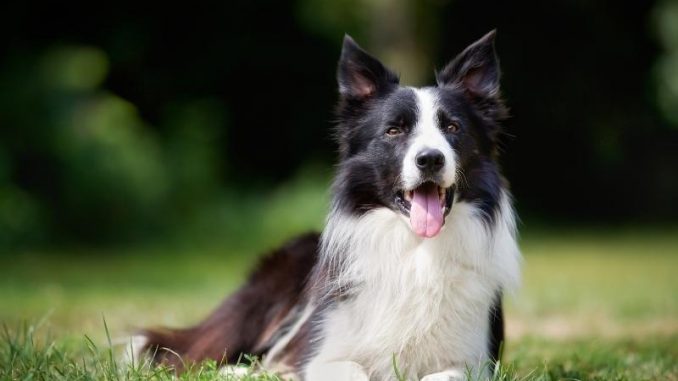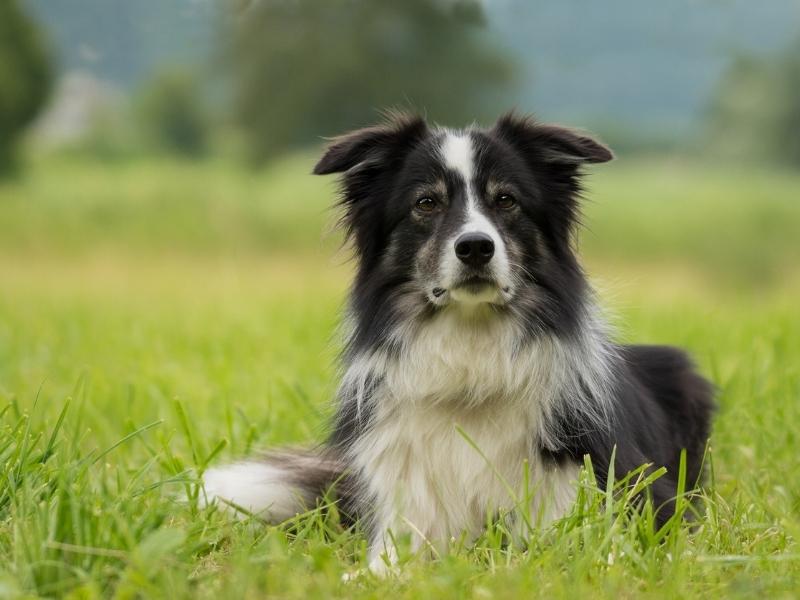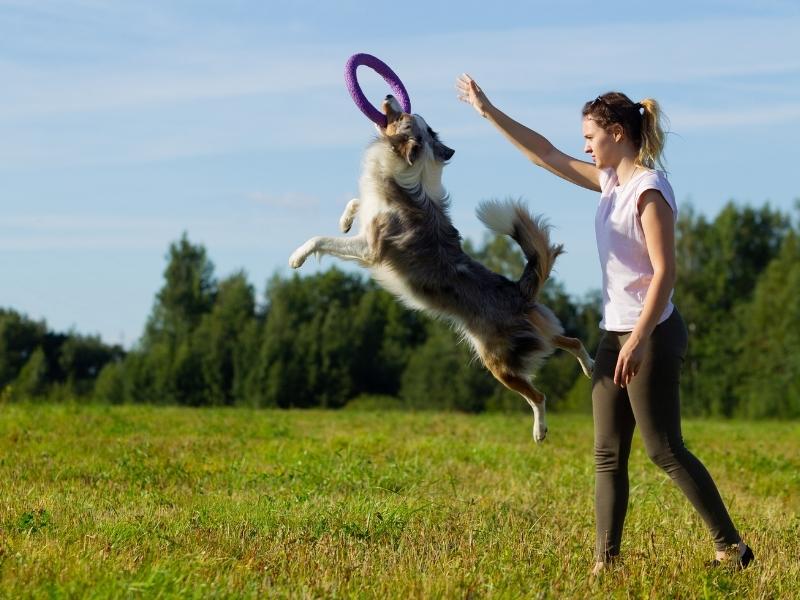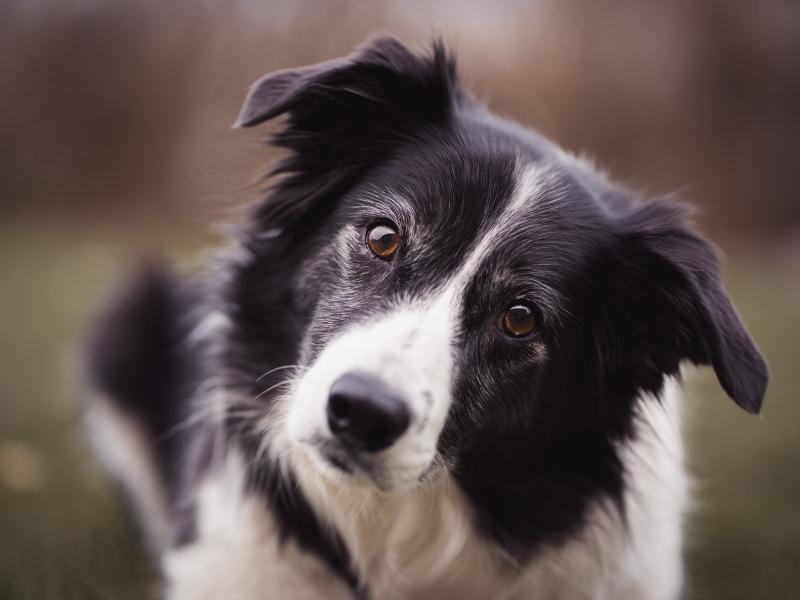
The border collie is a smart, energetic, medium-sized dog breed, reaching 18–23 inches tall and 26–44 pounds in weight. Border collies live between 10 and 17 years.
With their athletic builds and eager personalities, border collies are best suited to owners with the time and energy for a highly active pet.
Border collies are affectionate dogs that are good with children, but due to the dogs’ herding instincts, they shouldn’t be homed with small or nervous children.
TABLE OF CONTENTS
Border Collie Quick Summary
| Breed Type | Pastoral group (herding dog) |
| Size | Males: 19–23 inches
Females: 18–21 inches |
| Weight | Males: 30–44 pounds
Females: 26–42 pounds |
| Coat | Double-coated long fur |
| Color Variations | Black, white, blue, blue merle, red merle, chocolate, sable merle, brindle, gold, lilac, red |
| Shedding | Moderate throughout the year, heavy during shedding season |
| Personality | Intelligent, alert, keen, energetic, loyal, responsive, athletic, eager to please |
| Lifespan | 10–17 years |
| Cost | $600–$1,500 |
| Exercise Needs | High. Minimum 90 minutes of exercise per day |
| Food Requirements | 700–1,400 caloric intake, depending on the dog’s age and activity level |
| Known Health Conditions | Joint problems, eye conditions |
| Trainability | Good |
Border Collie Appearance

Border collies are long-furred, medium-sized dogs with long bodies and erect ears that droop at the tips.
Border collies come in a variety of color combinations, including black and white, tan and white, blue merle, slate merle, red and white, and tri-colored.
Height and Weight
On average, male border collies grow to 19–23 inches tall, while females grow to 18–21 inches tall.
At eight weeks old, collie puppies weigh between 3 and 5.5 pounds. The dogs grow rapidly until they reach 24–36 months old, when they reach their full weight of 26 to 44 pounds.
A border collie’s weight depends on its gender (males are 4–6 pounds heavier than females), its diet, and activity level.
Coat
There are two types of border collie coats: smooth and rough. Both are double coats, with a soft undercoat and a coarse outer coat.
Short haired border collies have smooth fur with minimal feathering, while rough collies have mid-length fur with feathering on the belly, legs, and chest.
The coat of a border collie is commonly black or tan, with white patches on the feet, legs, face, neck, and tail tips.
Border collies are usually bicolor, but tricolor and solid-color collie variations are also available.
Head and Facial Features
The border collie has a wedge-shaped head that’s broad and flat between the ears, with a strong muzzle that tapers towards the nose.
The border collie is best known for herding livestock. The breed’s almond-shaped eyes characterize their intelligent, hallmark “herding gaze.”
Border Collie Origins

Border collies are descended from landrace collies, a dog breed originating from the Anglo-Scottish in the British Isles.
The word “collie” comes from a Celtic word, meaning “useful” – border collies were originally bred for their usefulness as sheepdogs.
All the pure lines of today’s border collies can be traced back to a tricolor working dog called Old Hemp.
Sheep responded easily to Old Hemp, and the dog’s herding style became the traditional border collie style. Old Hemp was thought to have fathered more than 200 puppies.
Border Collie Personality and Temperament

Border collies are loyal, inquisitive dogs with a lot of energy to release. The smart, hardworking characteristics of the border collie make the dog easy to train.
Training border collies is recommended because untrained collies are more likely to be hyper and excessively vocal.
The border collie breed has some shy tendencies, which can develop into hostility towards other dogs and people if the dog isn’t properly socialized.
Because border collies are energetic and highly active, the dogs are better suited to homes in semi-rural or rural areas, with plenty of space to play.
Border collies have a natural instinct to chase or herd. This makes them unsuitable for families with small children or other pets unless the dogs are properly trained, to prevent behavioral issues.
Taking Care of a Border Collie Dog

Caring for a border collie is easy, as long as you have enough time and space to give this energetic dog breed what it needs.
To properly care for a border collie, regularly groom your dog, provide a balanced, high-quality diet, and keep your collie mentally and physically stimulated with exercise and playtime.
Food Needs
Border collies eat 700–1,400 calories per day, depending on the dog’s age and activity level. The more active the dog, the more calories it’ll burn every day, and the more food it will require to sustain a healthy weight.
The average daily food requirement for adult border collies is 1.5 to 2 cups of quality kibble per day, twice per day.
Young border collie puppies should be fed smaller amounts of food more frequently, around 1 cup of dry puppy food four times per day.
Provide high-quality, age-appropriate dog food for your border collie. Avoid giving too many treats in between meals, which increases the risk of obesity.
Leave clean, fresh water in an accessible location for your dog to drink throughout the day.
Grooming Needs
Grooming border collies is easy, and the same grooming technique can be used for grooming smooth- and rough-coated border collies.
Brush your dog with a pin brush twice a week, or as much as is needed. During shedding seasons in the spring and fall, brush your dog every day to remove molted fur.
Long-fur collies are more prone to matting and tangles, and are more likely than short-fur collies to accumulate dirt in their coats.
To ensure your border collie can walk properly, clip your dog’s nails once every four or five weeks.
Exercise Needs
The border collie is an athletic, highly-driven breed that requires a lot of daily exercise. A quick walk in the park or playtime in the yard isn’t enough for this dog.
Border collies prefer space to run and enjoy having a purpose during exercise. Provide at least 90 minutes of varied, intense exercise — such as a brisk walk, jogging, or fetch — per day.
Non-working border collies need vigorous exercise to be satisfied. When walking a border collie, bring sports equipment like dog-safe frisbees and tennis balls for your pet to play with.
Aside from walking, border collies enjoy participating in herding, agility exercises, obedience, tracking, and rally events and competitions.
Border collies are breeds for active owners, not sedentary owners or owners who lead busy lifestyles and can’t fit in the time to walk their dogs.
Border collies are best suited to homes with a back garden, allowing the dogs to stretch their legs and let off energy in between walks and playtime.
Mental Needs
Border collies are highly intelligent dogs that become easily bored without adequate mental stimulation. Provide at least 30 minutes of active stimulation for your dog every day.
Playtime with toys is essential for this dog breed. Use tug-of-war toys, chew toys, and fetch toys, and rotate the toys throughout the week to keep your dog engaged.
Puzzle toys are a good way to keep a border collie entertained when you’re not able to play with the dog yourself.
Common Health Concerns
Border collies are hardy and healthy. Buying a border collie puppy from a responsible breeder, who screens their parent dogs for illnesses, will greatly reduce the risk of hereditary conditions like hip dysplasia and collie eye anomaly.
Even so, screening only reduces the risk of a collie developing certain conditions, and can’t eliminate the risk entirely.
Some of the common health concerns in collies are:
- Hip dysplasia: Occurs when the hip joint doesn’t fit together properly. Exacerbated by poor nutrition, obesity, and certain types of exercise. Treated with lifestyle changes and, in severe cases, surgery.
- Collie eye anomaly: Caused by the improper development of the eye. Affects the retina, choroid, and sclera. Causes partial or complete blindness, depending on the severity of the disease. No treatment currently available.
- Sensory Neuropathy: A progressive nerve disease that affects mobility. Causes limp joints, poor coordination, confusion, excessive leg chewing or licking, and urinary incontinence. No treatment currently available.
- Epilepsy: A brain disorder that causes seizures or abnormal behaviors like fly-catching, and tail and shadow chasing. Symptoms present themselves in dogs between one and four years old. The disease can be controlled with long-term medication.
How to Train a Border Collie

Border collies are intelligent and easy to train. Begin puppy training from three to four months old.
Training shouldn’t only be used to teach your dog tricks — proper training will also prevent behavioral issues, such as herding, stalking, and car chasing.
Ensure your dog is socialized early, in the first few months of its life. Provide positive exposure to a variety of situations, locations, and people until the puppy is seven months old.
Begin with basic training, teaching your dog to sit, play fetch, sleep in its crate, and go to the toilet in the right place.
Once your dog has mastered the basics, move on to more complex training commands, such as “wait,” “heel,” “drop it,” and “quiet.”
Use treats and positive reinforcements during training. Don’t shout at or scold your border collie because this will cause the dog to become scared of you and hinder the training process.
Border Collie Price

Border collies are a mid-range dog breed. The upfront cost of a border collie is within most peoples’ budgets, and the cost of raising a border collie is low.
How Much is a Border Collie?
The cost of a purebred border collie is $600 to $1,200. The health status of the parents, the uniqueness of the puppy’s coloring and markings, and the age of the dog all affect the cost of the border collie.
Adult border collies are cheaper than puppies, and slate merle, red merle, and lilac merle border collies are cheaper than standard black and white collies.
Show-quality border collies are the most expensive, costing about $1,500. Border collies are often found in rehoming shelters, and the cost of adopting a dog is between $150 and $350.
Adult border collies are more commonly available for adoption than puppies.
How Much Does it Cost to Raise a Border Collie?
The first-year expenses of buying and raising a border collie are $1,200–$2,600, depending on the cost of the dog and associated vet bills.
The monthly cost of raising a border collie, after the initial costs, is $125–$150. This includes monthly vet bills, food, and new toys.
Should You Get a Border Collie?

Border collies are smart, playful dogs that make fantastic pets for active families. However, border collies aren’t suitable for some people or lifestyles. Consider your living situation carefully before getting a border collie.
Border Collies are Suitable for:
The border collie is ideal for singles, couples, and families with enough time to keep their pet mentally and physically stimulated with long walks, training, and lots of playtime.
Although border collies are adaptable dogs, they’re best suited to homes with medium-to-large gardens, preferably in semi-rural or rural regions, away from heavy traffic.
The energetic, even-tempered, and eager-to-please nature of the border collie makes this dog a loyal companion for families with older children and adult-only households.
Border Collies are NOT Suitable for:
Border collies become restless, stressed, destructive, and depressed when they’re under-stimulated, so they’re not suitable for inactive people or people who can’t make the time to walk and play with their pets.
Families looking for an easygoing dog that doesn’t need much exercise shouldn’t buy a border collie. Border collies aren’t well-suited for apartment living because they need plenty of space to move.
Although border collies are protective of children, the dogs are better suited to families with older children that won’t chase the pet.
FAQs
- How Long Does a Border Collie Live?
- How Much Exercise Does a Border Collie Need?
- How Big Does a Border Collie Get?
- How Much Does a Border Collie Cost?
- Are Border Collies High Maintenance?
- Are Border Collies Good With Kids?
- Are Male or Female Border Collies Better?
- Are Border Collies Clever?
- Are Border Collies Easy to Train?
- Can a Border Collie be Left Alone?
- Are Border Collies Well-behaved?
- Is a Border Collie a Good House Dog?

Be the first to comment